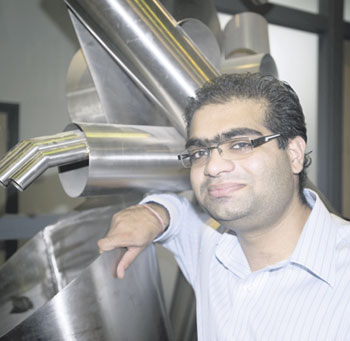Name: Hemant Sharma (25)Nationality: IndianPromoter: Professor Jilt Sietsma (faculty of Mechanical, Maritime and Materials Engineering, section microstructure control in metals)Subject: Fabrication of high temperature resistant steelThesis defense: In two years“I broke my leg ten years ago, and it was repaired with a plate of titanium – a very thin piece.
Since then I have been fascinated with metals.
I develop steels that can resist high temperatures. The best steel that exists today can withstand up to 650°C before it starts to weaken. This record is held by Japanese researchers, but we are now in the process of making a steel alloy that is better than that. My project involves a number of steel companies, including Arcelor Mittal and Corus. The ultimate goal is to make steel that can resist 1100°C, which of course is a very big challenge.
The World Trade Center towers collapsed when the temperature went beyond 550°C. Those buildings were in fact designed to withstand higher temperatures, since the steel was covered with a fire-resistant coating, but due to the explosions the coating was blown away.
If we can make steel stronger, we wouldn’t need coatings, which cost as much as the steel itself and need to be replaced routinely, and thus we could make buildings that are more resistant to fires and are cheaper.
Steel is made out of grains, small crystallites the size of a few micrometers. The smaller these are, the stronger the steel. When the metal is heated, these grains begin to grow. One way to prevent the grains from growing is by adding atoms of elements, like carbon, niobium, copper or titanium, to the metal. When the steel heats up, these atoms combine to form nanoparticles. These nanoparticles slow down the growth of the grains. So you could say that we develop a smart material which can adapt to conditions during a fire.
To study the growth of the grains in the presence of the nanoparticles, we look inside the opaque steel with synchrotron radiation, a very intense beam of high energy X-rays. We do this using the 3-Dimensional X-Ray Diffraction Microscope at the European Synchrotron Radiation Facility (ESRF) in Grenoble, France. This is a particle accelerator specially tuned for generating high intensity x-rays. We go there to conduct experiments around four times per year.
In order to control the experiments very accurately, we have developed a special furnace – for dedicated use at the supermicroscope – for accurate temperature control of the steel samples, which are the size of the lead of a pencil.
After I have finished my PhD, I’d like to continue conducting fundamental research. I don’t like industrial, profit-driven projects very much. I want to understand what happens inside metals on the very fundamental level.
“Maybe I will stay here and do a postdoc. On the other hand, I miss Indian food a lot.”
TU Delft techno-starter company, Ephicas, has won 100,000 euro in the final of the Dutch Postcode Lottery’s ‘Green Challenge’. Some 313 detailed plans from researchers around the world were submitted for the competition, which offered a first prize of 500,000 euro and two runners-up prizes each worth 100,000 euro. Ephicas developed an aerodynamic side-wing for trucks – called the Ephicas Sidewing – that substantially improves a truck’s fuel-efficiency.



Comments are closed.